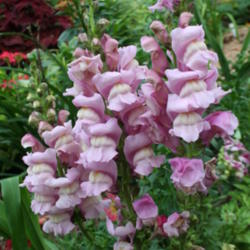| For a number of years now, our ROCKET snapdragon plants have produce healthy strongstemed spikes at the beginning of the season. Then, one by one, the plants wilt and die green in a few days. No leaf curl, no spots, just wilt. I have tried purchasing plants from different nurseries as well as planting my own seeds (Burpee, of course). I tried rotating the plants from season to season with the same results. The soil is slightly thick (clay) but have added peat by continuously - and other flowers and veggies seem to thrive. The only clue I can provide is that when I pull up the plant, the root system seems to be compace and almost the same size as the tray from which it was transplanted. (However, the ones that do not wilt seem to have the same size and compact root system. Can you suggest a solution - we hate to see such beautiful snapdragon spikes die almost overnight. Should I somehow cut open the root system when transplanting? Can they be root-bound? Thanks so much for this service. |

In addition, clay soil can be difficult to work with; you need to be careful to work the soil when it is moist but not sticky. If the soil is still on the heavy side it is possible that it is acting like a barrier to rooting (effectively acting the same as a pot would) so that the roots stay in the original potting soil within the original planting hole. To combat this, be sure to dig a very generous hole so that there is loose soil surrounding the rootball. To improve the soil structure, you need to add copious amounts of organic matter -- even working in a six inch layer is not too much! Peat is one type, but you might also consider other types with slightly larger particle sizes such as rotted leaves, half finished compost, aged stable manure with bedding and so on. This will help the soil hold both water and air and loosen it enough to aid rooting. You might also add a small amount of sand (half an inch or so), although do not go overboard with it as we all know sand and clay make brick when that mixture dries out. Finally, be sure the soil pH is near neutral as these plants prefer that over the typically acid east coast clay. Good luck with those snaps! |